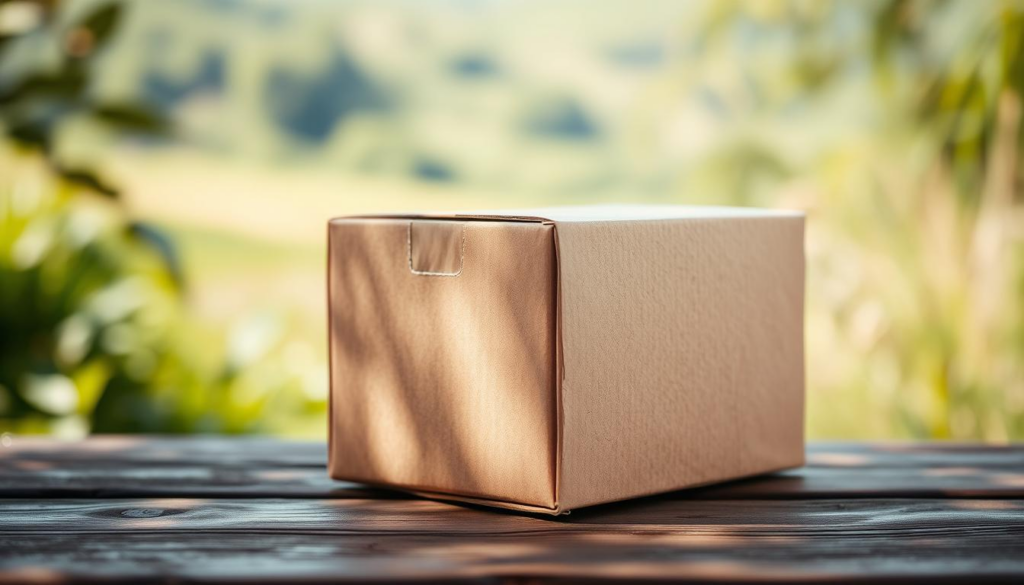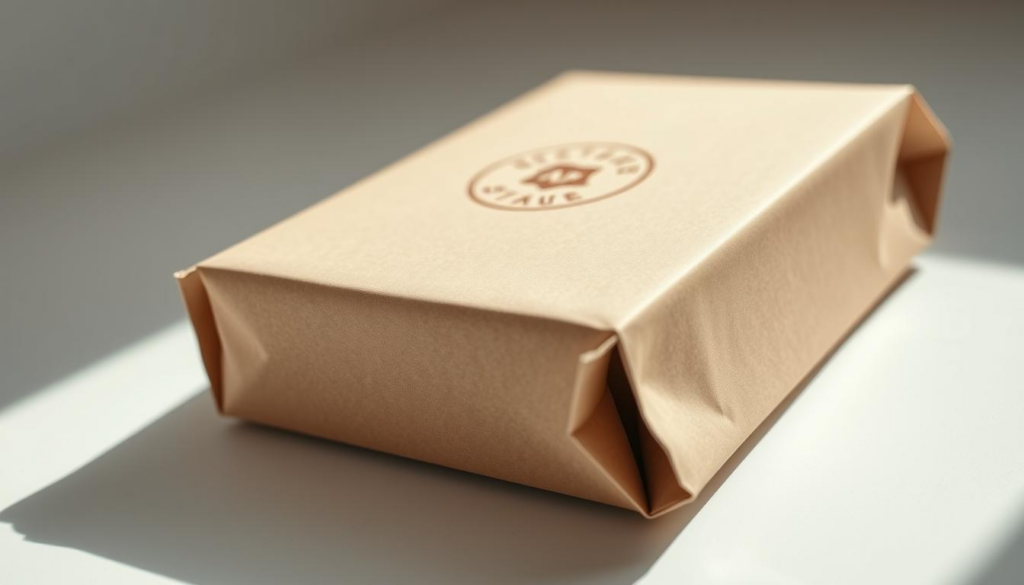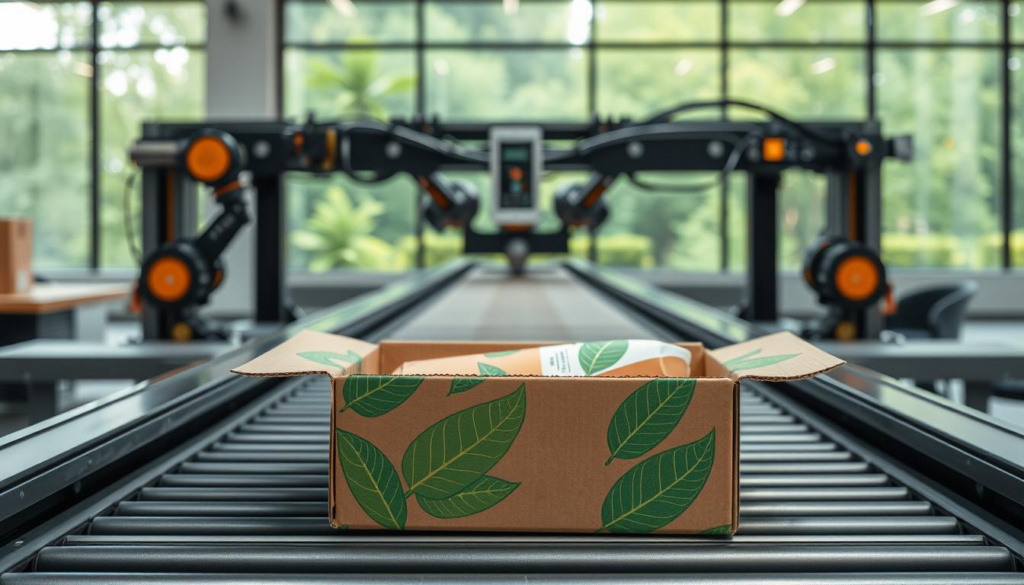In today’s world, brands are focusing more on sustainable packaging labels. This is because people want to buy products that are good for the planet. Companies are now using materials like compostables, recycled contents, and renewable resources for their labels.
Elevate Packaging’s PURE Labels™ is a standout. It’s the only certified compostable label in North America. These labels are not just useful; they also help reduce harm to the environment.

Labels and packaging providers are also working together. They’re turning label materials into electricity, cutting down on fossil fuel use. This move towards green packaging is good for our planet and meets the expectations of eco-aware consumers.
Key Takeaways
- Sustainable packaging labels are key to reducing environmental harm.
- Innovations like Elevate Packaging’s PURE Labels™ lead the way in eco-friendly solutions.
- Using lightweight and recyclable materials helps lessen environmental impact.
- Collaborations in waste-to-energy projects show a strong commitment to sustainability.
- Choosing recyclable materials supports sustainable economic practices.
Understanding Sustainable Packaging
Sustainable packaging uses materials and processes to cut down on environmental impact. It uses eco-friendly materials like recycled or compostable ones. This helps brands reduce waste and lower their carbon footprint.
More and more brands are choosing eco-friendly packaging. This choice influences about 55% of consumers when they buy products. The global market for sustainable packaging is expected to hit $500 billion by 2027, growing at 5.7% annually.
Millennials are driving this demand, with 73% of them willing to pay extra for sustainable products. The benefits of sustainable packaging are clear. Using recycled materials can cut carbon emissions by up to 50%.
Compostable materials are also gaining ground, with a 15% increase in use in the food industry over two years. Switching to sustainable packaging can boost a brand’s image, with 40% of companies seeing better perception after making the change.
Traditional packaging generates a lot of waste, making up 28.1% of municipal solid waste in the U.S. Sustainable packaging is a key way for brands to help the environment. As more consumers become aware, companies that focus on sustainability will stand out.
The Importance of Eco-Friendly Labels
Eco-friendly labels are key for brands wanting to show their green efforts. They not only point out a product’s environmental perks but also boost the brand’s image. Today, people want to buy from companies that care about the planet.
Switching to green materials shows the industry’s dedication to lessening its carbon footprint. Labels made from compostable, recycled, or plant-based stuff help a brand look good and meet strict green rules.
Using eco-friendly labels can also make a company more efficient. A smart labeling plan cuts down on waste and saves materials. It also shares a brand’s green message with customers who value the environment.
Adding eco-friendly labels is essential for following rules and building trust with customers. It shows a brand is serious about being green. This makes a brand stand out in a market that values sustainability.
Types of Sustainable Packaging Labels
Brands are now focusing on eco-friendly packaging labels. This shift meets the growing demand for green options. Each label type has its own benefits, like reducing waste and using resources wisely.
Compostable Labels
Compostable labels break down into organic matter easily. They’re great for brands wanting to cut down on waste. Labels like PURE Labels™ from Elevate Packaging are made from plant-based materials.
They meet strict standards and are perfect for food and organic cosmetics. This lets consumers know they can safely throw them away, knowing they’ll decompose.
Recycled Material Labels
Labels made from recycled materials help the environment a lot. They keep waste out of landfills and can be made from recycled films and papers. For example, HERMA uses 100% recycled paper to protect forests.
Labels made from silphia paper also save water and energy. This makes them a sustainable choice for packaging.
Reusable Labels
Reusable labels help reduce waste by not needing new labels for each use. They’re perfect for products that get returned or refilled. Wash-off labels, for instance, make PET bottles recyclable without leaving harmful residues.
This encourages consumers to recycle more. It also helps reduce our reliance on single-use plastics.
Packaging Labels: Why They Matter
In today’s market, packaging labels are key. They show what a product is about and help people decide to buy it. About 70% of shoppers pick a product based on its label design when they see similar ones.
Product labeling is important for sharing a brand’s story, what’s in it, how to use it, and if it’s good for the planet. This helps engage customers.
Labels that match a brand well can make customers recognize and stick with it more. Labels that show a brand cares about the environment can make 50% of people want to buy more. Labels that are clear and honest can build trust by 60%, which is big in areas like CBD.
In a busy market, packaging and labels are almost as important as the product itself. Brands with nice, informative labels can sell up to 30% more. Also, 75% of people like products that show they’re good for the planet on the label.
Labels do more than just look good; they shape what people think of a product. About 61% of shoppers think packaging’s look, feel, and shape matter a lot. And 34% might not buy something again if the packaging is bad. Labels also show a product’s quality, with 65% of people saying they help them make good choices.
Custom Labels for Sustainable Brands
Today, custom labels are key for green brands. They mix eco-friendly stuff with cool looks to grab people’s attention. This way, they show they care about the planet.
Label Design Innovations
Companies are using new tech to make labels stand out. They make labels that last as long as usual ones but are better for the earth. For example, some labels are made from stuff that can be composted.
These new labels also cut down on waste. Brands like Avery offer labels that are good for the planet. They use recycled stuff and inks that are safe for the environment.
Label Customization Options
Brands can make labels that really show who they are. They can pick from lots of materials, finishes, and sizes. This makes sure the labels look good and do their job well.
Labels can be for all sorts of products, like food and cosmetics. The many options help brands look consistent. This can make customers trust them more and want to buy more.
Label Printing Techniques That Reduce Environmental Impact
The world of label printing is changing for the better. New techniques are being developed to be more eco-friendly. These changes help both businesses and the environment.
Digital label printing is a big step forward. It cuts down on waste by not needing old printing plates. Studies show it can also reduce waste by making labels only when needed.
Bioplastics and recycled paper labels are also gaining ground. They’re better for the planet than traditional labels. LED-UV printing is another innovation, using less energy and drying faster.
Good quality control is key to less waste. Automated systems help catch mistakes early. This makes labels better and saves resources.
More people care about the environment, with 74% of U.S. adults worried about it. Using eco-friendly materials in label printing helps. It cuts down on pollution and supports nature.

| Technique | Benefits | Impact Reduction |
|---|---|---|
| Digital Printing | Reduces material waste, enables on-demand production | Wastage reduced by 28% |
| Bioplastics | Lower environmental impact compared to petroleum-based labels | Significant reduction in resource consumption |
| LED-UV Printing | Lower electricity consumption, faster drying times | 33% reduction in energy consumption |
| Quality Control Systems | Minimizes material losses due to defects | Improves accuracy and reduces waste |
| Sustainable Materials | Supports recycling and reduces deforestation | Decreases carbon consumption by 32% |
Choosing the Right Label Manufacturer
Choosing the right label manufacturer is key to sustainable packaging. It’s important to find eco-friendly manufacturers. Look at their sustainability practices, like the materials they use and waste management.
Brands should look for certifications that show a commitment to green practices. This ensures the manufacturer shares your eco-conscious values. It helps meet environmental goals.
Criteria for Eco-Friendly Manufacturers
When looking for eco-friendly manufacturers, consider these points:
- Material Sourcing: Make sure they use recycled and renewable materials.
- Sustainability Initiatives: Check if they have a dedicated sustainability team.
- Waste Management: See if they reduce waste by not sending it to landfills.
- Energy Efficiency: Check their energy use and efforts to save energy.
Benefits of Local Sourcing
Choosing local label manufacturers has many benefits. It reduces carbon emissions from transportation. It also supports local economies, helping communities grow.
Working with local producers means better communication about sustainability. They can also respond quickly to urgent needs, like in the craft brewing industry.
Challenges in Sustainable Label Solutions
The market for sustainable labels is growing fast, but it faces many challenges. One big issue is the cost of eco-friendly materials. Companies have to spend a lot to buy these materials, which can raise their prices.
It’s also important to teach consumers how to recycle these labels. If people don’t know how to dispose of them right, the labels won’t be as effective.
Finding sustainable materials is hard. Ten years ago, there were just a few options. Now, there are hundreds because big companies want to be greener. But, even with more choices, some brands find it hard to get the right materials.
New laws are pushing for more sustainability. For example, California is cracking down on false recycling claims. This shows a big change in how we handle waste. More companies are being asked to take care of waste costs, not just local governments.
There are also efforts to make recycling easier across the U.S. But, these are just starting out.
The world of sustainable labels is always changing. For example, some labels are made from 100% recycled materials. Others are clear and made from recyclable materials, helping to reduce waste. Companies that use these materials can look better to customers who care about the environment.

| Challenge | Description |
|---|---|
| Cost | Higher expenses related to eco-friendly materials affect pricing strategies. |
| Consumer Education | Need for clear guidance on proper disposal of labels to maximize recycling. |
| Material Availability | Inconsistent supply of sustainable materials complicates label production. |
| Regulatory Compliance | Increased scrutiny and regulations around sustainability claims impact manufacturers. |
| Standardization Efforts | Movements to unify recycling practices are in developmental stages. |
As companies try to be greener, they face many challenges. But, they are also working hard to find better solutions. This will shape the future of labeling in the industry.
Future Trends in Eco-Friendly Packaging Labels
The world of sustainable labels is changing fast. More and more people want to buy products that are good for the planet. This has led to a big move away from plastic labels to paper-based ones.
These new labels are made from materials that are better for the environment. They use fewer chemicals and break down faster. This is a big step towards a greener future.
PLAs (polylactic acid) are a key part of this change. They can break down in just months when composted. Water-based inks and non-toxic adhesives are also becoming more popular. They help keep our air and water clean and make labels easier to remove.
The demand for eco-friendly labels is growing fast. By 2025, many companies will make sustainability a key part of their packaging. This is because more people want to buy products that are good for the planet.
There are many trends in sustainable labels, like simple designs and clear labels. These trends are what consumers want to see. They make labels not just useful but also appealing.
But there are challenges too. Changing to sustainable labels can be expensive and hard to do. Companies need to find ways to overcome these problems. Those that focus on recyclable materials will likely do well.
By 2025, most companies will show off their green efforts on their labels. They will use eco-friendly inks and materials. This will show their commitment to the environment.
Conclusion
Sustainable packaging labels are key in today’s branding and caring for the environment. With more people buying things than ever, brands must rethink their packaging. Choosing eco-friendly options shows they care and helps fight waste and pollution.
Good packaging design, like labels, helps products stand out and makes choices easier for buyers. As people become more aware of green issues, brands need to offer better, greener labels. Those that do will not only succeed but also lead a big change in how products are shown and sold.
The push for sustainable packaging labels shows a brand’s dedication to quality and honesty. Labels are getting better, with designs and materials that meet many needs. This includes being easy to read and looking good. So, the future of green packaging is about making labels even better and showing they’re important for brands and responsible shopping.
FAQ
What are sustainable packaging labels?
Sustainable packaging labels aim to reduce environmental harm. They use materials that can be recycled, composted, or come from renewable sources. This helps cut down on waste and saves energy.
How do compostable labels benefit the environment?
Compostable labels break down into natural matter, cutting down on waste. Brands like Elevate Packaging’s PURE Labels™ use these labels. They ensure their labels don’t end up in landfills.
Why are eco-friendly labels important for brands?
Eco-friendly labels show a brand’s dedication to the environment. They improve a brand’s image and gain consumer trust. They also meet growing environmental regulations.
What types of materials can be used for sustainable labels?
Sustainable labels can be made from compostable substrates, recycled paper, and films with recycled content. Plant-based options also help lower carbon emissions.
How can brands customize their labels while being eco-friendly?
Brands can pick sustainable materials, finishes, sizes, and adhesives that fit their values and style. This way, they can express their brand while being green.
What printing techniques are recommended for eco-friendly labels?
Use solvent-free inks and digital printing to cut down on resources. Innovations like linerless labels and lightweight materials also reduce waste.
What should companies consider when choosing a label manufacturer?
Look at the manufacturer’s green practices, materials, waste policies, and environmental rules. Certifications show their commitment to being eco-friendly.
What are some challenges brands face in using sustainable labels?
Challenges include higher costs for eco-friendly materials and educating consumers on disposal. Limited availability of sustainable materials is also a hurdle.
What future trends can we expect in sustainable packaging labels?
Expect advanced materials like 100% wood-based options and more recycling-friendly labels. New technologies will make labels more recyclable, aiming for greater sustainability.